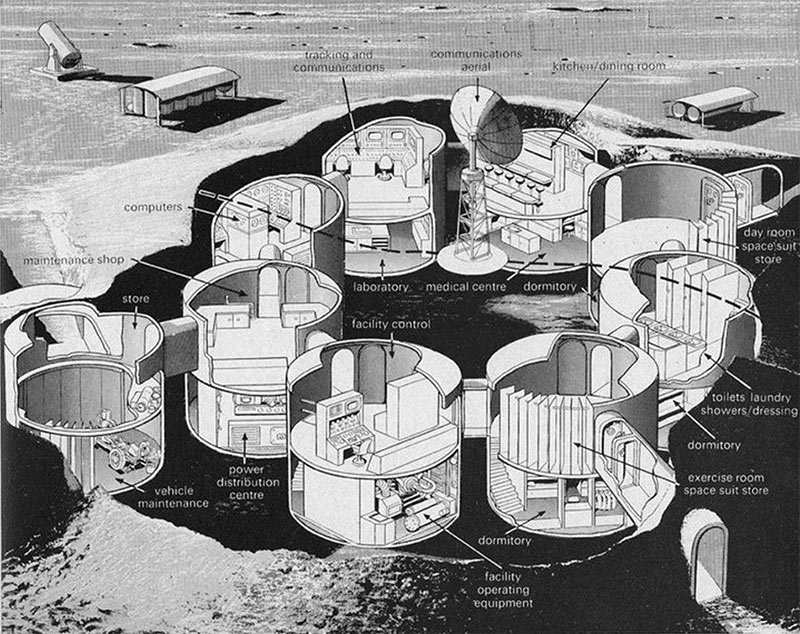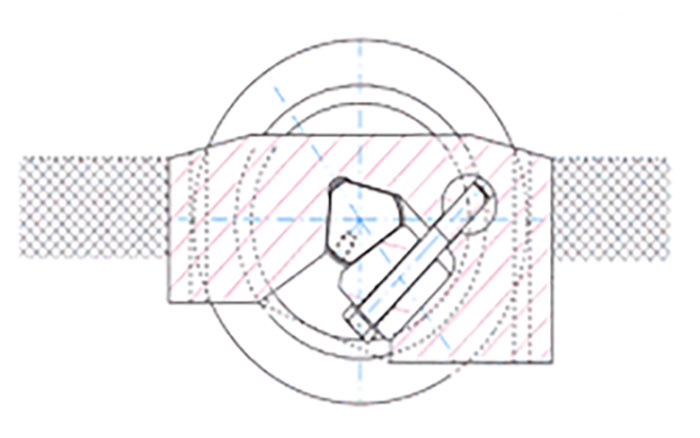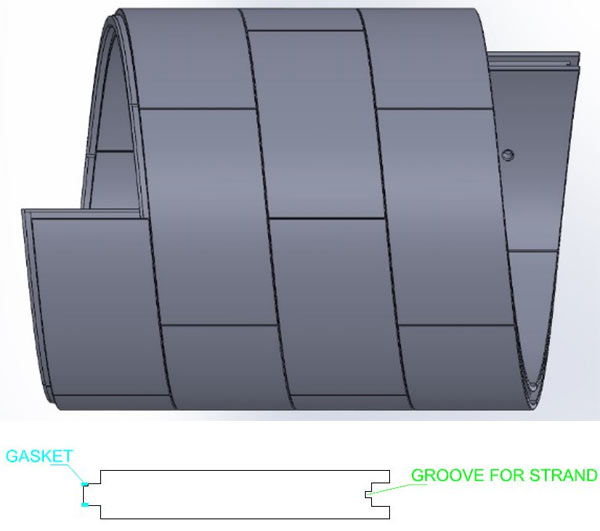TBMs designed for excavations on the moon Jun 2019
Reaching for deep space is no longer a scientific fantasy, but rather a possibility for commercial applications and perhaps a necessity as resources on earth become stretched. With the advent of reusable rockets, establishment of bases on the moon has attracted renewed attention.
Establishing bases on the moon underground seems to be a logical choice as they would protect future lunar inhabitants and equipment from the harsh environment at the surface, including the vacuum environment, impact by meteorites, radiation, extreme temperatures, storms, and other unknown conditions integral to long-term activities on the moon.
Developing rilles (ancient lava flows that formed into hollow structures as the outer layers of lava cooled), and lava tubes could create underground spaces to house bases the size of large cities with tunneled interconnections. Lava tubes could also provide skylights to the surface, with special filters to mimic the natural light on the earth (Figs 1 and 2).
As well as the potential for developing rilles and lava tubes, limited exploration has shown that water ice, carbon dioxide, and several other volatiles are present in and near the permanently shadowed craters of the lunar north and south poles. Tunneling presents expanded opportunities to access and extract these resources. LTBMs could also be adapted for the frozen regolith (the layer of material covering the solid rock such as soil or dust) in the permanently shadowed craters at the lunar poles, which may be an attractive option for access to lunar ice resources. Other TBM adjustments would be needed to overcome vacuum and lack of breathable atmosphere, surface temperature variations, impacts by micrometeorites, and high levels of radiation.
Advantages of underground bases would include:
Providing atmosphere: Given that lack of atmosphere means near absolute vacuum on the moon, pressurizing an underground space to 1 bar or 100 kpa pressure and maintaining the temperature and moisture content to near that of the earth could be achieved by using a natural impermeable membrane for maintaining the air pressure.
Thermal stability: Surface temperature varies from about -190°C to +120°C between day and night at the lunar equator. It is ±3K at 30cm beneath the lunar surface and there is no day/night variation below 700mm. Permafrost may present challenges when excavating through lunar ice.

Radiation shielding: Radiation from solar flares and galactic cosmic rays is a serious concern and regolith could provide radiation with densely packed regolith more than 4m+ deep at the crown to provide a safe living environment for long term use.
Micrometeorite protection: The lunar surface is constantly bombarded with meteorites. Covering a lunar habitat with regolith would protect from micrometeorites, while a deeper underground space would protect from larger meteorite impacts.
The concept of a lunar tunnel boring machine (LTBM) has been proposed before and an early conceptual design was developed.3 With new discoveries about the moon and recent advances in TBM technology a re-examination of the value and possibilities of building man-made structures on the moon is a step closer to reality.
Lunar geotechnical considerations
The geology on the moon is expected to be a 10cm layer of regolith, highly compacted within the first 10-20cm, with boulders and fractured rock, deeper intact bedrock, basaltic in the Mare regions and anorthositic in the Highlands. Frozen regolith at the polar regions would combine fine grained to coarse grained rock including boulders of anorthosite mixed with icy volatiles, creating a permafrost region with variable mechanical strength.
Until further investigations, face conditions on the moon will be mixed with more challenging conditions for cutting through the frozen regolith at the polar regions and through boulders and bedrock, requiring high cutting forces that cannot be supported by the weight of the surface equipment, if cut and cover method were to be used.
The following are some of the challenges that one can imagine as part of using TBMs for development of underground bases or mining operations on the moon.
Weight Limits: A 2m to 3m diameter TBM can weigh more than 100 ton, including the backup systems and trailing gear. This is based on using low-cost steel for the support structures with gearboxes, cutterheads, cutting tools and disc cutters. Alternatives are needed for LTBMs to reduce weight specifically for transporting the components on rockets to the moon. The primary support structure could be manufactured from lunar resources such as cast basalt or compressed sintered regolith reinforced with metallic members or basaltic tensile fibers. Using carbon fiber composite parts and lighter composites or alloys for various parts of the machine is also a possibility. Switching materials will have implications on repairs and maintenance such as welding of the parts and that should be considered in the design.
Temperature: Material behaves differently at low temperatures, with most metals being brittle at temperatures below 50°C. Extensive research is needed to characterize the material properties at temperatures anticipated at the face. Materials for seals will be critical to success of disc cutters, as well as lubricants for disc cutters exposed to very low face temperatures. The use of graphite could be a possible solution as a lubricant in various parts of the machine.
Power and energy consumption: TBMs are power-hungry with 2m to 3m diameter TBMs requiring 500-700 kWe of input power. Variable frequency drive systems are typically used on TBMs with feed cables carrying 5-25kV power to the machine where it is transformed to 480V, 660V, or 1000V for the drive units. To achieve low energy consumption per excavated volume, high forces, and thus high power, are necessary. Low force excavation methods like thermal spalling or microwave excavation require larger amounts of energy than the most efficient mechanical methods (Fig 6). In an environment where power and weight levels have to be kept low but energy must be conserved, a dilemma is faced and lunar TBMs may require excavation techniques that are not economical on earth. High efficiency components should be employed wherever possible in order to use every bit of power that is available and minimize sources of energy loss in the machine. Low friction bearings, high efficiency drive systems, and preventing power losses from electrical to mechanical will all be a part of the equation to make LTBMs a reality. The use of nuclear or solar power could meet the demand for a typical TBM, so this target could be within reach.
Abrasivity: The regolith and bedrock of basalt encountered on the moon are known to be abrasive due to the mineralogy of the material being from harder silicates. Regolith is reported to be jagged with sharp edges due to the process of meteorite impact fragmentation as opposed to the typical erosional processes on the earth. As a result cutting tools and machine components will wear at much higher rates. The use of conditioning agents in the excavation chambers may reduce machine torque and wear.
Vacuum: Lack of atmosphere and working in a vacuum pose significant challenges. Putting a system in place where pressure can be built up inside the tunnel will be easier with operations entirely in hard rock. A sealed tunnel heading entrance and tunnel design to support pressure will have three benefits.
- First the capture of valuable volatiles created during the tunnelling process.
- Second to enable later use of tunnels to contain an atmosphere for human habitation.
- Third, it would allow for use of earth-normal methods and operations which would simplify the LTBM design process and operation.
Problems with vacuum operations include the lack of convective heat transfer. This could result in excessive heating of the cutting tools and components of the TBM drive system and other thermal management issues. Another issue is extreme high and low temperatures at the surface and limited possibility for heat exchange to maintain an ambient and acceptable temperature. Thermal conditions would stabilize once the TBM is deeper beneath the surface. Needs for human intervention maintenance of LTBMs would require the wearing of space suits which will limit the ability of workers to do their job. This limitation will place special emphasis on the clever use of automated systems and robotics to the greatest extent possible.
Lack of flushing/cooling material: Lack of atmosphere and fluids on the moon surface means lack of flushing material for probing ahead of the machine or installing roof bolts. There will also be no way of using fluids to dissipate heat generated by motors and VFD drive systems as well as motors used for pumps, cooling systems of the transformers, and all other heat generating units.
Ground stability and support: For lunar tunneling, support tools could be made from Kevlar or carbon fiber with light polymer or resin based cements sprayed on the tunnel surface. Special segments could be cast from light materials such as 3D printed rock powder to form air-tight rings in the same way soft-ground machines easily keep 7-8 bar of water pressure at bay.
Maintaining air pressure in the opening: Atmospheric pressures would need to be maintained inside the tunnel heading to allow the crew to work in normal conditions. A similar example on earth is TBM operations under high groundwater pressure where shielded machines work under air tight support installed within the tail shield. Lunar tunnels are not expected to be deeper than 100m so the rock would contain the stresses.
Material transportation: A set of airlocks could allow the transition of materials in and out of the tunnel between vacuum and atmospheric pressure. Muck transfer could be as a fluidized particle flow by a gas supply on the LTBM.
Utilities: Most important of support utilities require by TBMs is an electricity supply. Compressed air lines are the second priority, which would also maintain atmospheric pressure in the tunnel. Installation of water lines for cooling and dust suppression appears less important for lunar tunnelling. Ventilation of the heading will require specialized air filtering and cleaning systems to re-supply the oxygen used at the heading. Systems similar to those currently used on the space station can function as the ventilation system, while the heat exchangers will make up for lack of heat transfer of ventilation in terrestrial tunnelling. Monitoring and communication systems are expected to function the same on the moon as on earth but need shielding against radiation at the portal. Rail will not be needed as trackless vehicles can transport men and materials.
Other Issues: Fluids such as hydraulic oil should be re-evaluated for LTBM operations as they are heavy and need to be tested and maintained on a regular basis. Components and electronic parts sensitive to temperature would need to be insulated, and against radiation, especially for surface transfer.
Ground investigation ahead of the machine would be a critical issue for lunar TBM operations. Ground penetrating radar (GPR) is a possibility for geological probing. Geophones and similar sensors deployed ahead of the machine on the surface could also anticipate ground conditions using micro-seismic techniques. Another alternative is the use of smart probe drilling systems (Fig 5).
In parallel, there is recent development of a helical segmental lining system that allows continuous operation of the TBM while supporting the ground and sealing the heading for pressurized working conditions. This is accomplished by using an integrated gasket in the tongue and groove joints to prevent water ingress in terrestrial applications and for preventing air escape for working on a lunar application (Fig 6).
Considering the need to excavate underground space to establish manned bases on the moon, TBMs seem to be most promising excavation method. TBMs have a good track record of activities on the earth, are the easiest systems to automate and operate remotely, and are capable of offering high performance. Further research is required to meet the very specific challenges of operating such equipment in the lunar environment and offer a safe and efficient excavation operation.
Authors References
- McKay, Mary Fae, David S. McKay, and Michael B. Duke, 1992, Space resources. Volume 4: Social Concerns
- Blair, D M., Chappaz, L, Sood, R, Milbury, C, Bobet, A, Melosh, H. J., Howell, K. C., and Freed, A. M., 2017, "The structural stability of lunar lava tubes." Icarus 282, 47-55.
- Allen, Christopher S., et al., 1988, Proposal for a lunar tunnel-boring machine, NASA-CR-184746, NAS 1.26:184746
References
- Microwave-assisted hard rock excavation – TunnelTalk, January 2018
|
|
|
|
|
Add your comment
- Thank you for taking the time to share your thoughts and comments. You share in the wider tunnelling community, so please keep your comments smart and civil. Don't attack other readers personally, and keep your language professional.









